What is the difference between tinyint(1) and tinyint(4) in Mysql
1. The difference between varchar(M) and numerical type tinyint(M)
String type: For varchar(M), M is the maximum character that can be stored in the field String, that is to say the field length. Depending on the settings, when the value you insert exceeds the length of the field setting, you are likely to receive an error prompt. If you do not receive a prompt, the inserted data may also be automatically truncated to fit the predefined length of the field. Everything like varchar(5) means that the length of the stored string cannot exceed 5.
Numeric column type: The length modifier indicates the maximum width and has nothing to do with the physical storage of the field, that is, when tinyint(1) and tinyint(4) are signed The storage range is -128 to 127 (without a sign, it is 0 to 255).
Note: The signed default range (-128~127), the default length is 4.
# #If zerofill is used, when the actual length does not reach the specified display length, it will be filled in front with 0.
In the data type of MySQL, tinyin is related to whether it is signed or not. The signed value range is -128~127. The unsigned value range is 0~255. The number in parentheses has nothing to do with the stored value, only the display width in some cases.
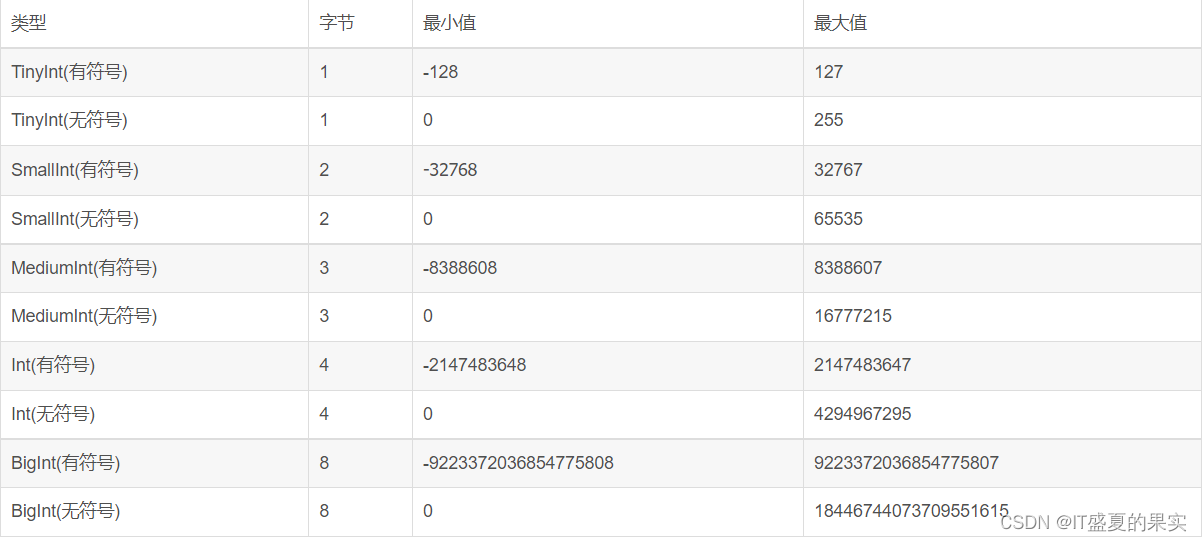 2 Test
2 Test
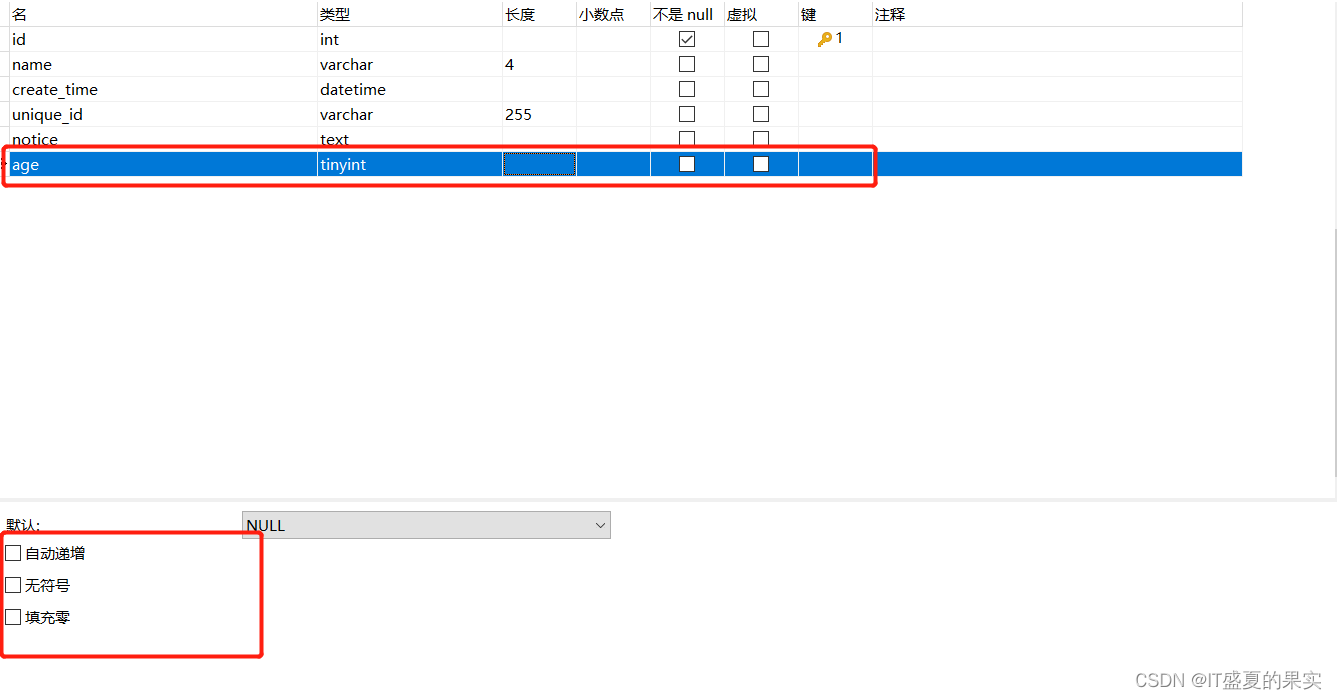
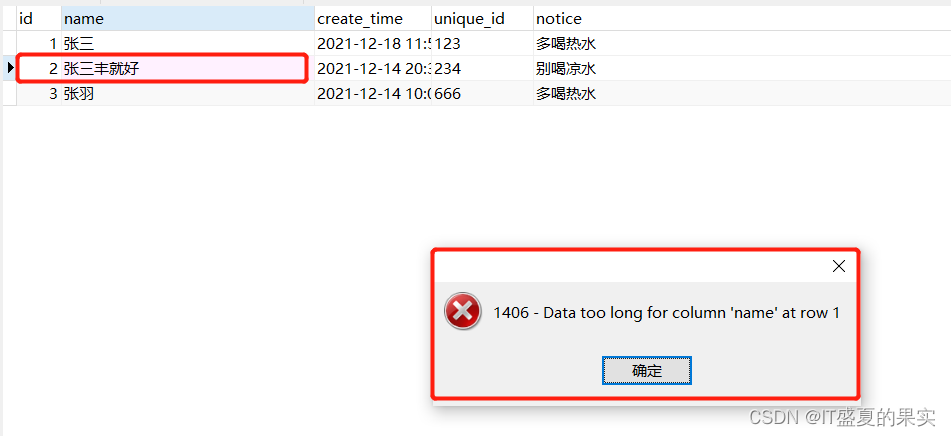 What happens when the tinyint type (signed) age field is set outside the range (-128~127)?
What happens when the tinyint type (signed) age field is set outside the range (-128~127)?
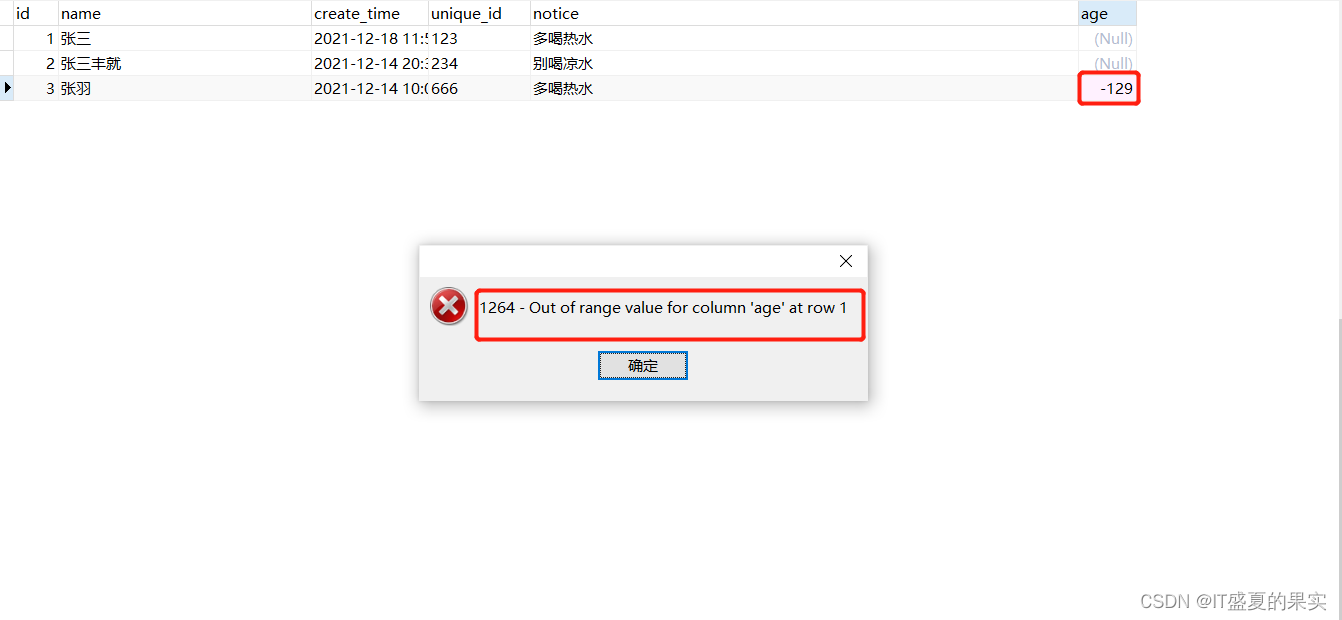
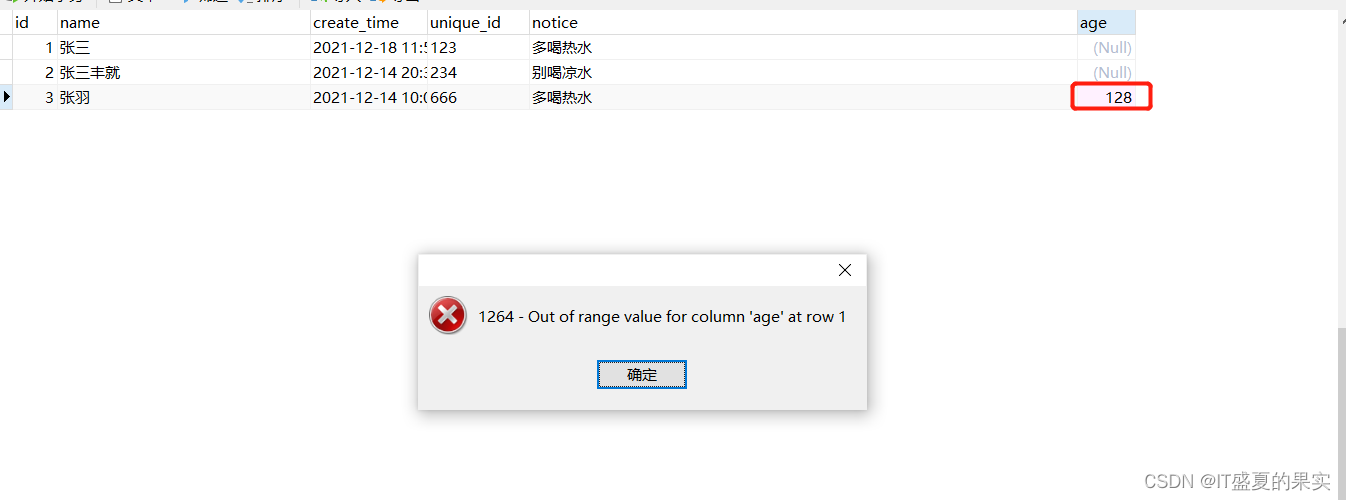 1 bytes = 8 bit, the maximum length of data that can be represented by one byte is 2 to the 8th power 11111111. Also in computers It is
1 bytes = 8 bit, the maximum length of data that can be represented by one byte is 2 to the 8th power 11111111. Also in computers It is
-128 to 127
1.BIT[M]
bit field type, M represents the number of digits in each value, ranging from 1 to 64, if M Ignored, defaults to 1
2.TINYINT[(M)] [UNSIGNED] [ZEROFILL] M defaults to 4
, a small integer. The signed range is -128 to 127. The unsigned range is 0 to 255.
3. BOOL, BOOLEAN
is a synonym for TINYINT(1). A value of zero is considered false. Non-zero values are considered true.
4.SMALLINT[(M)] [UNSIGNED] [ZEROFILL] M defaults to a small integer of 6
. The signed range is -32768 to 32767. The unsigned range is 0 to 65535.
5.MEDIUMINT[(M)] [UNSIGNED] [ZEROFILL] M defaults to 9
A medium-sized integer. The signed range is -8388608 to 8388607. The unsigned range is 0 to 16777215.
6. INT[(M)] [UNSIGNED] [ZEROFILL] M defaults to 11
A normal-sized integer. The signed range is -2147483648 to 2147483647. The unsigned range is 0 to 4294967295.
7.BIGINT[(M)] [UNSIGNED] [ZEROFILL] M defaults to 20
big integer. The symbolic interval is -9223372036854775808 to 9223372036854775807. The unsigned range is 0 to 18446744073709551615.
Note: The M here does not represent the specific length stored in the database. In the past, I always mistakenly thought that int(3) can only store 3-length numbers, int(11) will store 11-length numbers, which is totally wrong.The above is the detailed content of What is the difference between tinyint(1) and tinyint(4) in Mysql. For more information, please follow other related articles on the PHP Chinese website!

Hot AI Tools

Undresser.AI Undress
AI-powered app for creating realistic nude photos

AI Clothes Remover
Online AI tool for removing clothes from photos.

Undress AI Tool
Undress images for free

Clothoff.io
AI clothes remover

Video Face Swap
Swap faces in any video effortlessly with our completely free AI face swap tool!

Hot Article

Hot Tools

Notepad++7.3.1
Easy-to-use and free code editor

SublimeText3 Chinese version
Chinese version, very easy to use

Zend Studio 13.0.1
Powerful PHP integrated development environment

Dreamweaver CS6
Visual web development tools

SublimeText3 Mac version
God-level code editing software (SublimeText3)

Hot Topics
 MySQL: An Introduction to the World's Most Popular Database
Apr 12, 2025 am 12:18 AM
MySQL: An Introduction to the World's Most Popular Database
Apr 12, 2025 am 12:18 AM
MySQL is an open source relational database management system, mainly used to store and retrieve data quickly and reliably. Its working principle includes client requests, query resolution, execution of queries and return results. Examples of usage include creating tables, inserting and querying data, and advanced features such as JOIN operations. Common errors involve SQL syntax, data types, and permissions, and optimization suggestions include the use of indexes, optimized queries, and partitioning of tables.
 How to open phpmyadmin
Apr 10, 2025 pm 10:51 PM
How to open phpmyadmin
Apr 10, 2025 pm 10:51 PM
You can open phpMyAdmin through the following steps: 1. Log in to the website control panel; 2. Find and click the phpMyAdmin icon; 3. Enter MySQL credentials; 4. Click "Login".
 Why Use MySQL? Benefits and Advantages
Apr 12, 2025 am 12:17 AM
Why Use MySQL? Benefits and Advantages
Apr 12, 2025 am 12:17 AM
MySQL is chosen for its performance, reliability, ease of use, and community support. 1.MySQL provides efficient data storage and retrieval functions, supporting multiple data types and advanced query operations. 2. Adopt client-server architecture and multiple storage engines to support transaction and query optimization. 3. Easy to use, supports a variety of operating systems and programming languages. 4. Have strong community support and provide rich resources and solutions.
 MySQL's Place: Databases and Programming
Apr 13, 2025 am 12:18 AM
MySQL's Place: Databases and Programming
Apr 13, 2025 am 12:18 AM
MySQL's position in databases and programming is very important. It is an open source relational database management system that is widely used in various application scenarios. 1) MySQL provides efficient data storage, organization and retrieval functions, supporting Web, mobile and enterprise-level systems. 2) It uses a client-server architecture, supports multiple storage engines and index optimization. 3) Basic usages include creating tables and inserting data, and advanced usages involve multi-table JOINs and complex queries. 4) Frequently asked questions such as SQL syntax errors and performance issues can be debugged through the EXPLAIN command and slow query log. 5) Performance optimization methods include rational use of indexes, optimized query and use of caches. Best practices include using transactions and PreparedStatemen
 How to connect to the database of apache
Apr 13, 2025 pm 01:03 PM
How to connect to the database of apache
Apr 13, 2025 pm 01:03 PM
Apache connects to a database requires the following steps: Install the database driver. Configure the web.xml file to create a connection pool. Create a JDBC data source and specify the connection settings. Use the JDBC API to access the database from Java code, including getting connections, creating statements, binding parameters, executing queries or updates, and processing results.
 How to start mysql by docker
Apr 15, 2025 pm 12:09 PM
How to start mysql by docker
Apr 15, 2025 pm 12:09 PM
The process of starting MySQL in Docker consists of the following steps: Pull the MySQL image to create and start the container, set the root user password, and map the port verification connection Create the database and the user grants all permissions to the database
 MySQL's Role: Databases in Web Applications
Apr 17, 2025 am 12:23 AM
MySQL's Role: Databases in Web Applications
Apr 17, 2025 am 12:23 AM
The main role of MySQL in web applications is to store and manage data. 1.MySQL efficiently processes user information, product catalogs, transaction records and other data. 2. Through SQL query, developers can extract information from the database to generate dynamic content. 3.MySQL works based on the client-server model to ensure acceptable query speed.
 How to install mysql in centos7
Apr 14, 2025 pm 08:30 PM
How to install mysql in centos7
Apr 14, 2025 pm 08:30 PM
The key to installing MySQL elegantly is to add the official MySQL repository. The specific steps are as follows: Download the MySQL official GPG key to prevent phishing attacks. Add MySQL repository file: rpm -Uvh https://dev.mysql.com/get/mysql80-community-release-el7-3.noarch.rpm Update yum repository cache: yum update installation MySQL: yum install mysql-server startup MySQL service: systemctl start mysqld set up booting






